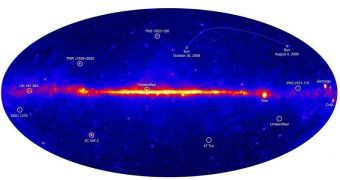The American space agency's Fermi gamma-ray telescope has only recently finished collecting over three months' worth of cosmological observations, with which astrophysicists and other scientists have put together the most detailed and extensive map of the Universe in existence today, at least as far as radiations go. This unprecedented view of the world around our planet has been made possible by Fermi's enormous observational capacity, which can detect gamma-rays from within our solar system, but also those coming from galaxies billions of light-years away.
“Fermi has given us a deeper and better-resolved view of the gamma-ray sky than any previous space mission. We're watching flares from supermassive black holes in distant galaxies and seeing pulsars, high-mass binary systems, and even a globular cluster in our own,” Stanford University expert Peter Michelson, who works as a lead scientist at the orbital observatory's Large Area Telescope (LAT) in California, says.
“This is the mission's first major science product, and it's a big step toward producing our first source catalog later this year,” Fermi Deputy Project Scientist David Thompson, who works at NASA's Goddard Space Flight Center, in Greenbelt, Maryland, adds. The team that handles the telescope has submitted the paper detailing the 205 brightest sources of gamma-rays observed to The Astrophysical Journal Supplement for publishing.
The released map contains data collected over the 87 days between August 4th and October 30th, 2008, and also features readings of our own Sun, which are inaccessible to any other space- or Earth-based observatory. “Because the sun appears to move against the background sky, it produces a faint arc across the upper right of the map. No other instrument will be able to observe solar flares in the LAT's energy range,” Michelson believes.
The most active sources of gamma-rays include supermassive black holes, pulsars, quasars, massive and neutron stars, as well as globular clusters. Fermi's new map comprises at least several of each, with the exception of clusters, of which it features only 47 Tucanae, formations of very old and large stars, located some 15,000 light-years away.

 14 DAY TRIAL //
14 DAY TRIAL //